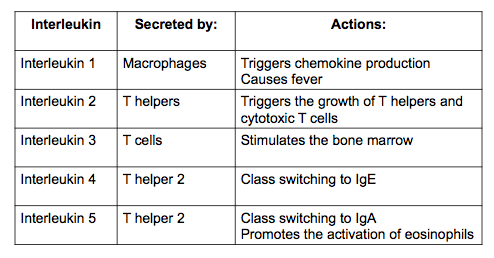WBR0490
| Author | [[PageAuthor::Rim Halaby, M.D. [1]]] |
|---|---|
| Exam Type | ExamType::USMLE Step 1 |
| Main Category | MainCategory::Immunology |
| Sub Category | SubCategory::General Principles |
| Prompt | Prompt::A 6-year-old female was brought to her pediatrician for fever and runny nose. The fever started two days ago and has not been responsive to anytipyritics. Which of the following inflammatory mediators is involved in the patient’s fever? |
| Answer A | AnswerA::Interleukin 1 |
| Answer A Explanation | [[AnswerAExp::Interleukin 1 affects the activity of hypothalamus, the thermoregulatory center, which leads to a raise of a body temperature, so called fever. That is why IL-1 is called endogenous pyrogen.]] |
| Answer B | AnswerB::Interleukin 2 |
| Answer B Explanation | [[AnswerBExp::Interleukin 2 is necessary for the growth, proliferation, and differentiation of T cells to become 'effector' T cells. It is secreted by the T helper cells. Interleukin 2 is not pyrogenic.]] |
| Answer C | AnswerC::Interleukin 3 |
| Answer C Explanation | [[AnswerCExp::Interleukin 3 is secreted by basophils and activated T cells to support growth and differentiation of T cells from the bone marrow in an immune response. Interleukin 3 is not pyrogenic.]] |
| Answer D | AnswerD::Interleukin 4 |
| Answer D Explanation | [[AnswerDExp::Interleukin 4 induces B-cell class switching to IgE, and up-regulates MHC class II production. IL-4 decreases the production of Th1 cells, macrophages, IFN-gamma, and dendritic cell IL-12. Interleukin 4 is not pyrogenic.]] |
| Answer E | AnswerE::Interleukin 5 |
| Answer E Explanation | [[AnswerEExp::Interleukin 5 is a major regulator of eosinophil accumulation in tissues, and can modulate eosinophil behavior at every stage from maturation to survival. Interleukin 5 is not pyrogenic.]] |
| Right Answer | RightAnswer::A |
| Explanation | [[Explanation::L-1 is intensely produced by tissue macrophages, monocytes, fibroblasts, and dendritic cells, but is also expressed by B lymphocytes, NK cells and epithelial cells. They form an important part of the inflammatory response of the body against infection. These cytokines increase the expression of adhesion factors on endothelial cells to enable transmigration (also called diapedesis) of immunocompetent cells, such as phagocytes, lymphocytes and others, to sites of infection. It also affects the activity of hypothalamus, the thermoregulatory center, which lead to a raise of a body temperature, so called fever. That is why IL-1 is called endogenous pyrogen. Besides of fever, IL-1 also causes hyperalgesia (increased pain sensitivity), vasodilation and hypotension.
Educational objective: Shown below is an image summarizing the roles of interleukins and the cells that secrete them. |
| Approved | Approved::No |
| Keyword | WBRKeyword::Interleukin, WBRKeyword::Fever |
| Linked Question | Linked:: |
| Order in Linked Questions | LinkedOrder:: |
